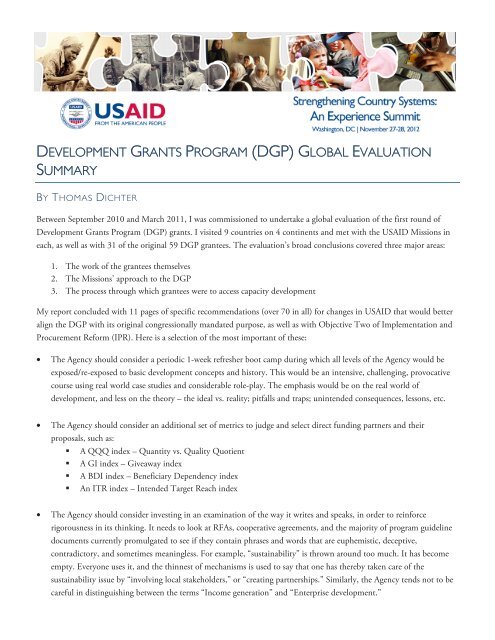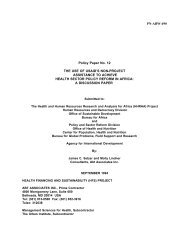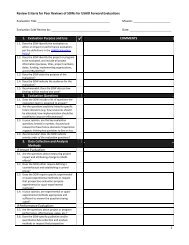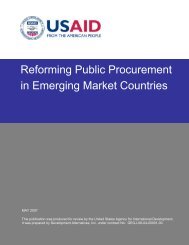development grants program (dgp) global evaluation summary
development grants program (dgp) global evaluation summary
development grants program (dgp) global evaluation summary
Create successful ePaper yourself
Turn your PDF publications into a flip-book with our unique Google optimized e-Paper software.
DEVELOPMENT GRANTS PROGRAM (DGP) GLOBAL EVALUATION<br />
SUMMARY<br />
BY THOMAS DICHTER<br />
Between September 2010 and March 2011, I was commissioned to undertake a <strong>global</strong> <strong>evaluation</strong> of the first round of<br />
Development Grants Program (DGP) <strong>grants</strong>. I visited 9 countries on 4 continents and met with the USAID Missions in<br />
each, as well as with 31 of the original 59 DGP grantees. The <strong>evaluation</strong>’s broad conclusions covered three major areas:<br />
1. The work of the grantees themselves<br />
2. The Missions’ approach to the DGP<br />
3. The process through which grantees were to access capacity <strong>development</strong><br />
My report concluded with 11 pages of specific recommendations (over 70 in all) for changes in USAID that would better<br />
align the DGP with its original congressionally mandated purpose, as well as with Objective Two of Implementation and<br />
Procurement Reform (IPR). Here is a selection of the most important of these:<br />
• The Agency should consider a periodic 1-week refresher boot camp during which all levels of the Agency would be<br />
exposed/re-exposed to basic <strong>development</strong> concepts and history. This would be an intensive, challenging, provocative<br />
course using real world case studies and considerable role-play. The emphasis would be on the real world of<br />
<strong>development</strong>, and less on the theory – the ideal vs. reality; pitfalls and traps; unintended consequences, lessons, etc.<br />
• The Agency should consider an additional set of metrics to judge and select direct funding partners and their<br />
proposals, such as:<br />
• A QQQ index – Quantity vs. Quality Quotient<br />
• A GI index – Giveaway index<br />
• A BDI index – Beneficiary Dependency index<br />
• An ITR index – Intended Target Reach index<br />
• The Agency should consider investing in an examination of the way it writes and speaks, in order to reinforce<br />
rigorousness in its thinking. It needs to look at RFAs, cooperative agreements, and the majority of <strong>program</strong> guideline<br />
documents currently promulgated to see if they contain phrases and words that are euphemistic, deceptive,<br />
contradictory, and sometimes meaningless. For example, “sustainability” is thrown around too much. It has become<br />
empty. Everyone uses it, and the thinnest of mechanisms is used to say that one has thereby taken care of the<br />
sustainability issue by “involving local stakeholders,” or “creating partnerships.” Similarly, the Agency tends not to be<br />
careful in distinguishing between the terms “Income generation” and “Enterprise <strong>development</strong>.”
• The Agency might consider creating a pocket-size reminder card, containing this set of questions to ask of prospective<br />
directly funded NGO applicants:<br />
• Is the project sensible, focused, and in line with what the applicant organization can really do?<br />
• Will the project be sustainable as proposed?<br />
• Can what is proposed be done in the timeframe and budget proposed?<br />
• Is the project likely to create dependency?<br />
• Does the project risk emphasizing quantity over quality?<br />
• Are the targets reasonable both in number and kind?<br />
• How much time will it take to start up?<br />
• Is the budget of the proposal leaving anything out?<br />
• USAID needs to give more consideration to the context in which local NGOs operate. In middle-income countries or<br />
countries on the path to <strong>development</strong> and growth, the role of the NGO can be seen differently than in the poorest<br />
countries. In the middle-income countries, local NGOs cannot be seen any longer as merely substituting for<br />
government inadequacy, or the lack of a vibrant private sector (e.g., in water systems). Considering context more<br />
carefully would mean seeing the civil society sector more dynamically and would mitigate the risk of using/seeing<br />
NGOs as a monolithic type, which in some countries may actually encourage a cementing in of their position, when<br />
we want the opposite.<br />
• If DGP is to continue, it should be made more gradual, experimental, and with a focus on <strong>development</strong> effectiveness.<br />
Quality and realism have to be at the core of selection guidelines; a much more rigorous approach to vetting and<br />
selecting needs to be instituted. This might mean fewer grantees until more lessons are learned and incorporated.<br />
• DGP grant timeframes should be better aligned with the reality of grantees’ slow project start-ups and with Mission<br />
cycles, including projected money flow timing. The funding guidelines should allow for a custom tailored start-up<br />
period. Thus, for example, a grantee might be given three to six months of salary and material procurement costs,<br />
which would enable them to hire the people they need, buy their equipment, but not begin the actual work until, say,<br />
the fourth month.<br />
• DGP guidelines on what constitutes local vs. a locally registered branch of an international NGO or a U.S. PVO need<br />
to be more carefully developed, but only after some discussion about what USAID wants to encourage. Some of the<br />
questions to be asked here are: Is there a significant correlation between new and small, and committed and effective?<br />
It might make sense to have a two-tiered approach – small local NGOs between 3 and 10 years old; and older NGOs<br />
that are locally registered parts of an International or U.S. PVO, but only if their HQ has experience in the same areas.<br />
Development Grants Program (DGP) Global Evaluation Summary 2
• The Agency might consider revising the rating system for concept notes with more of a focus on innovation,<br />
knowledge management, and sustainability.<br />
• There needs to be much more clarity at all stages in the process from the APS/RFA through the application process.<br />
Guidance needs to be stated more simply and repeated more often. Everything that can be clarified should be. Because<br />
of the psychology of potential local grantees and their expectations and the cachet attached to being associated with<br />
USAID, there is a strong tendency to hear what one wants.<br />
• Create a welcome kit for all proposal applicants – This would be two to three pages, easy to read (perhaps even using<br />
some cartoon characters), in FAQ style, covering not just the basics of how to apply (deadlines, length, email vs. mail,<br />
etc.), but a feel for which parts of the process the applicant is likely to find difficult, and what resources the applicant<br />
might turn to for help, plus, perhaps a paragraph on what happens if you are rejected. This “kit” could also emphasize<br />
the things that some grantees tend to leave out of their budgets (e.g., the cost of translation).<br />
• Missions need to be explicitly encouraged to conclude that in a given round of applicants, there are none worth<br />
funding. An obvious incentive not to pick the “best of the worst” would be to have a mechanism that allows Missions<br />
to carry-over DGP funds into the next round.<br />
• Excessive use of numerical target indicators should be avoided or eliminated. If part of the DGP focus is capacity<br />
building, innovation, learning, and knowledge <strong>development</strong>, firm numerical targets are contradictory to these aims.<br />
• The Agency needs to invest in understanding the psychology of local NGOs, especially those characteristics (like fear<br />
or diffidence) that tend to get in the way of good communication.<br />
• Capacity <strong>development</strong> (CD) needs to be thought of as having three foci:<br />
1. CD for generating <strong>development</strong> outcomes<br />
2. CD for organizational <strong>development</strong><br />
3. CD for how to work with USAID<br />
• Many local NGOs, of small and even medium size, encounter problems that are not necessarily covered in standard<br />
Organizational Development types of training. These are problems that have more to do with the up and down life<br />
cycle of small and new local NGOs (e.g., the tendency to start with lots of passion, but eventually burn-out, or fall<br />
into bureaucratic routines, or the classic issues around “founder’s syndrome”). Providers of Capacity Development<br />
need to be aware of these issues, and prepared to offer help on them in more creative ways than standard training<br />
approaches.<br />
Development Grants Program (DGP) Global Evaluation Summary 3







